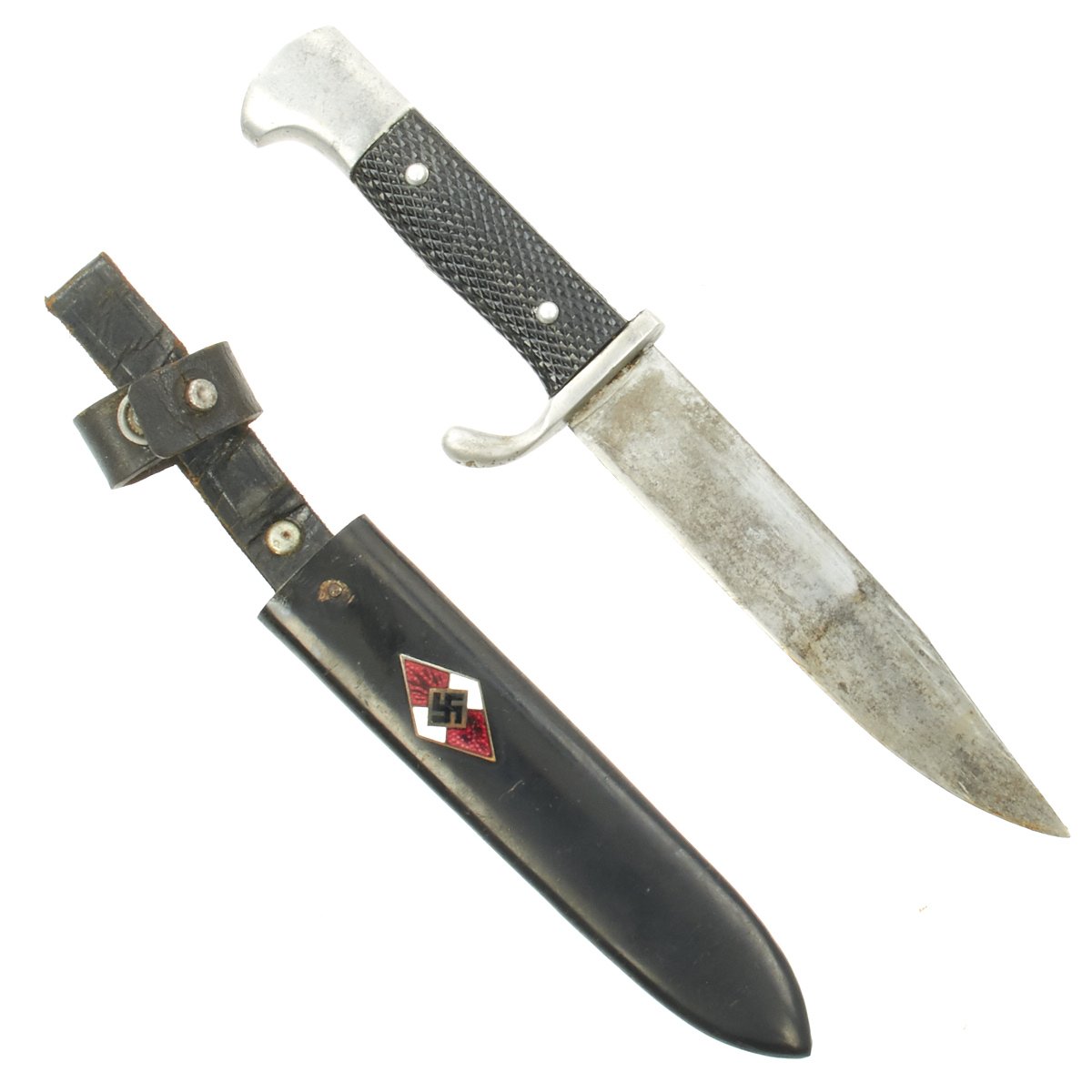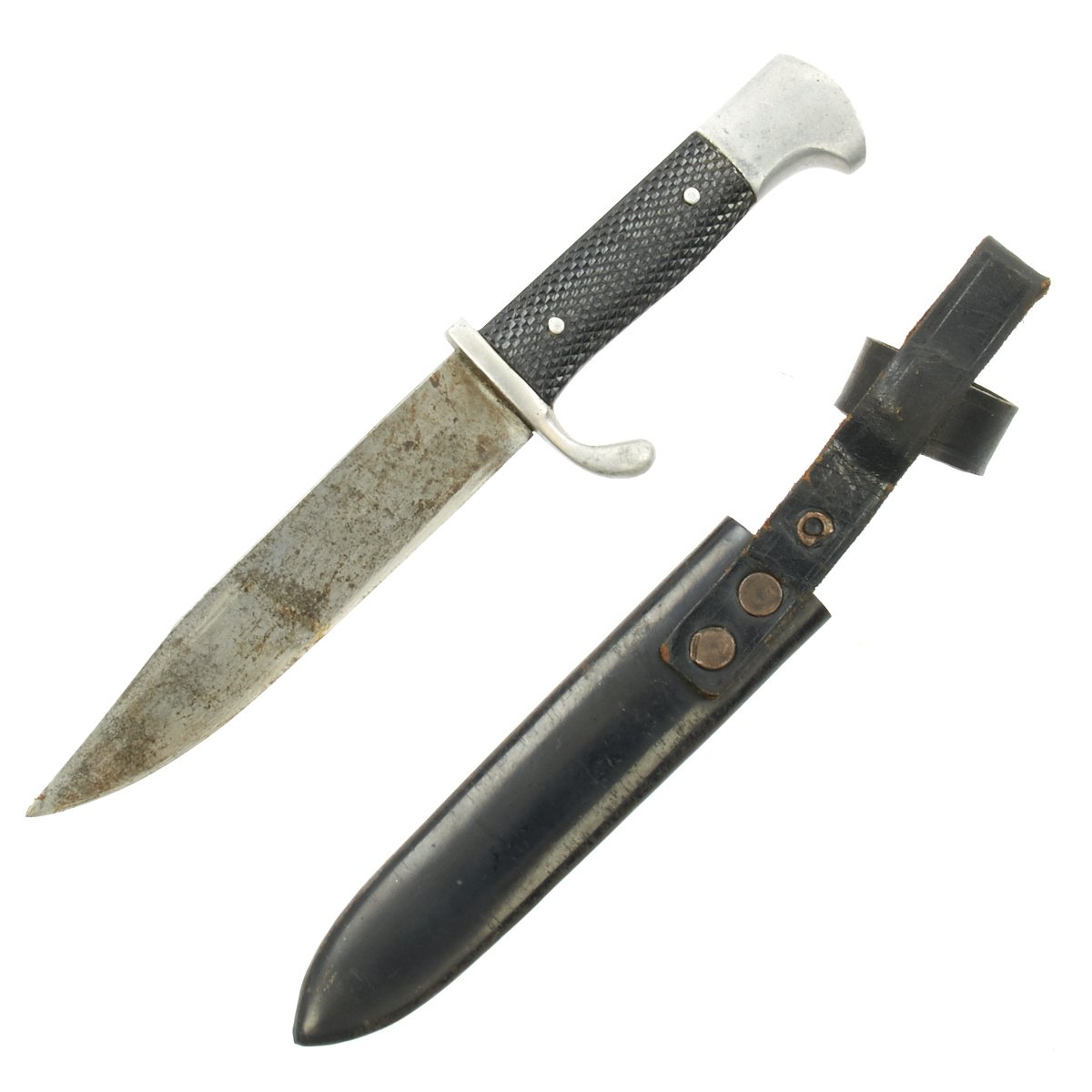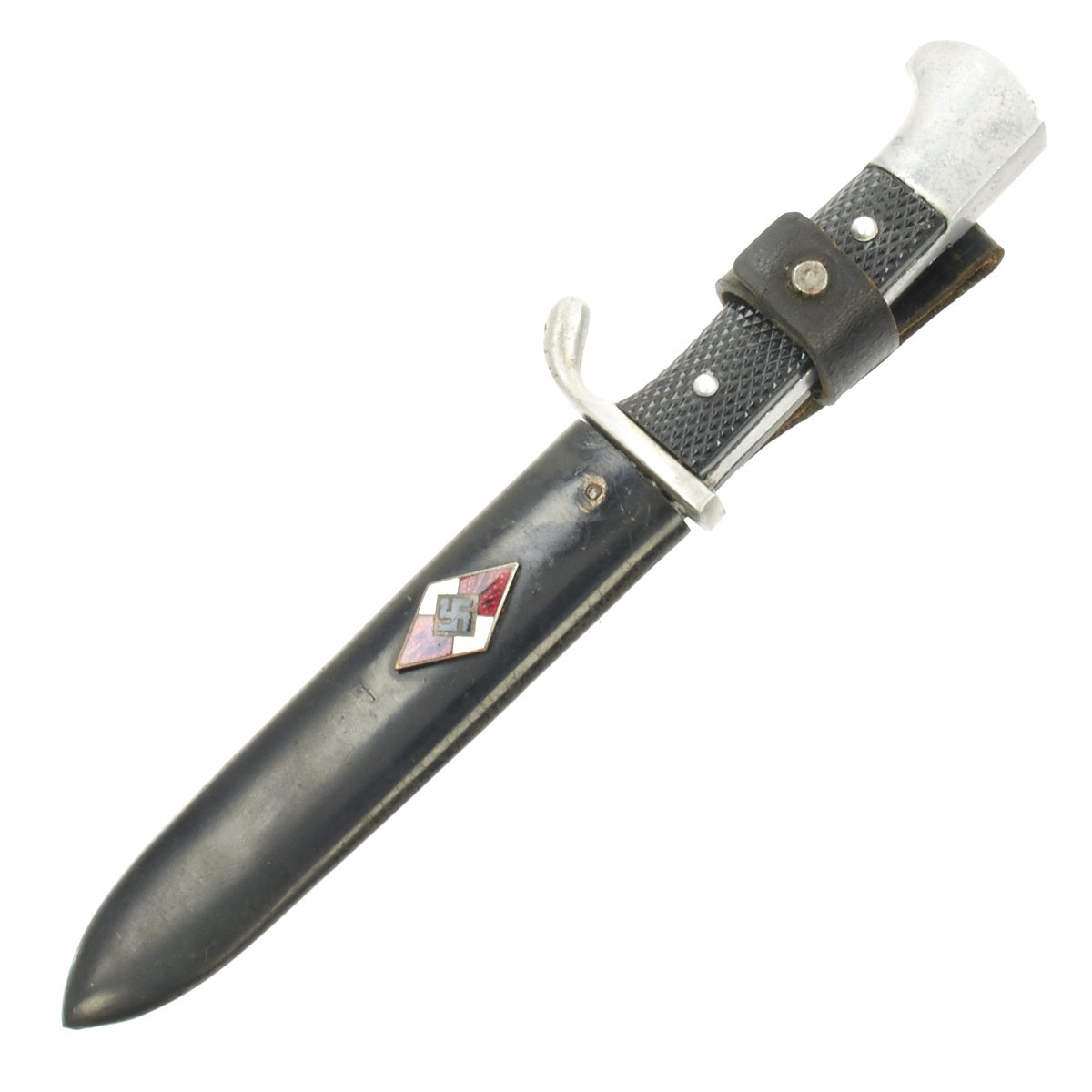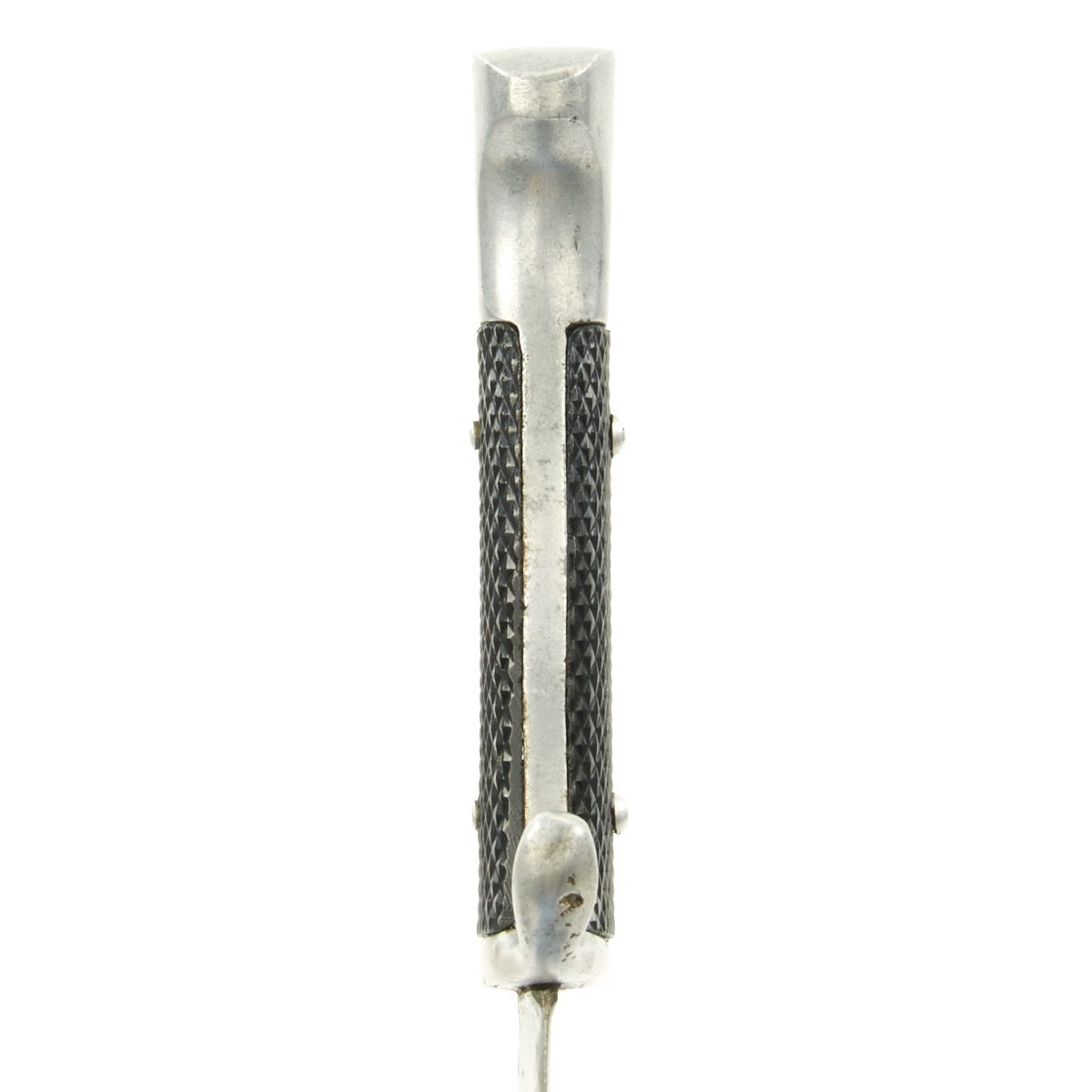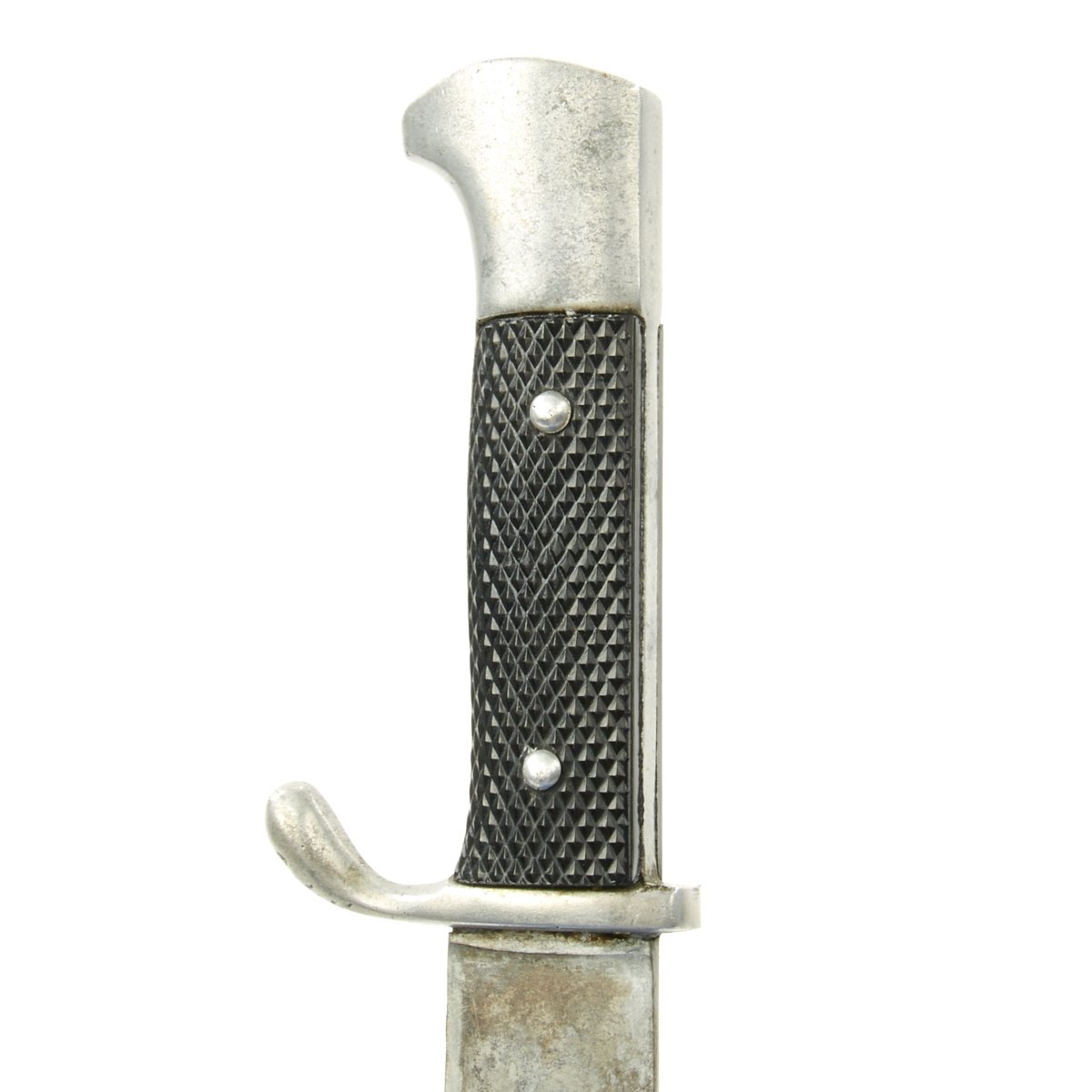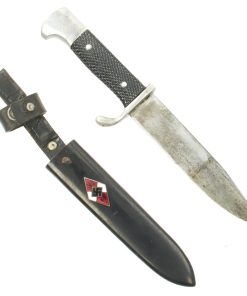Original German WWII BDM League of German Girls in the HJ Knife with Scabbard Original Items
$ 495,00 $ 148,50
Original Item: Only One Available. This is a nice example of the knife given to members of the Bund Deutscher Mädel in der AH-Jugend (League of German Girls in the HJ), the girls equivalent of the HJ. This organization is usually abbreviated BDM, and very few of these knives have been available on the market. They resemble a “scaled-down” version of the HJ knife, and usually feature and aluminum finish on the hilt and blade, which was mostly a sign of membership and achievement. They are stored in a small black lacquered scabbard, and have the HJ emblem attached to the scabbard, as opposed to set in the grip.
The hilt has about 40% of the original Aluminum finish remaining, with some areas where the base metal is exposed, with some light oxidation. The grip plates are the black checkered variety and are in very good condition, with just a bit of wear. They are retained by aluminum rivets with dressed obverse heads. There is no play in the grip connection. The blade is in good shape, but definitely saw use. It has been sharpened several times, and has a bit of staining in areas. There is no maker mark that we can see.
The scabbard is completely straight throughout with no dents, with a great enamel finish. There is some checking and crazing on the finish on the bath, but overall it is very good. The belt loop is black finished leather, with wear from use, but is overall solid. The securing strap is intact, with a functional snap. The enameled HJ insignia retains very bright colors and has a clean surface, with almost completely intact enamel. The plating has worn some of the brass portions though, so they are now a dull oxidized green color. Also there is some checking in the enamel, which has allowed the brass undercoat to oxidize in areas.
A wonderful and rare BDM knife, one of the few we have ever seen, and in really nice display condition.
The Bund Deutscher Mädel (League of German Girls/Maidens) of the HJ had its origins as early as the 1920s, in the first Mädchenschaften or Mädchengruppen, also known as Schwesternschaften der AH-Jugend (Sisterhood of the HJ). In 1930, it was founded as the female branch of the HJ movement. The league of German Maidens was nicknamed “The League of German Mattresses”, perhaps suggesting sexual promiscuity between the gender-separated groups. Its full title was Bund Deutscher Mädel in der AH-Jugend (League of German Girls in the HJ). In the final electioneering campaigns of 1932, AH inaugurated it with a mass meeting featuring the League; on election eve, the League and HJ staged “evening of entertainment.” It did not attract a mass following until the NSDAPs came to power in January 1933.
Soon after taking office as Reichsjugendführer on 17 June 1933, Baldur von Schirach issued regulations that suspended or forbid existing youth organizations (‘concurrence’). Those youth groups were compulsorily integrated into the BDM, which was declared to be the only legally permitted organization for girls in Germany. Many of the existing organizations closed down to avoid this.[citation needed] These NSDAP activities were a part of the Gleichschaltung (Equalization) starting in 1933. The Reichskonkordat between the Catholic Church and NSDAP Germany, signed on 20 July 1933, gave a certain shelter to the Catholic youth ministry, but they were the object of much bullying.
The Gesetz über die jugend (law concerning the HJ) dated 1 December 1936, forced all eligible juveniles to be a member of HJ or BDM. They had to be ethnic Germans, German citizens and free of hereditary diseases. Girls had to be 10 years of age to enter this League.
The BDM was run directly by Schirach until 1934, when Trude Mohr, a former postal worker, was appointed to the position of BDM-Reichsreferentin, or National Speaker of the BDM, reporting directly to Schirach. After Mohr married in 1937, she was required to resign her position (the BDM required members to be unmarried and without children in order to remain in leadership positions), and was succeeded by Dr. Jutta Rüdiger, a doctor of psychology from Düsseldorf, who was a more assertive leader than Mohr but nevertheless a close ally of Schirach, and also of his successor from 1940 as HJ leader, Artur Axmann. She joined Schirach in resisting efforts by the head of the NS-Frauenschaft (NSDAP Woman’s League), Gertrud Scholtz-Klink, to gain control of the BDM. Rüdiger led the BDM until its dissolution in 1945.
As in the HJ, separate sections of the BDM existed, according to the age of participants. Girls between the ages of 10 and 14 years old were members of the Young Girl’s League (Jungmädelbund, JM), and girls between the ages of 14 and 18 were members of the Bund Deutscher Mädel (BDM) proper. In 1938, a third section was added, known as Faith and Beauty (Glaube und Schönheit), which was voluntary and open to girls between 17 and 21 and was intended to groom them for marriage, domestic life, and future career goals. Ideally, girls were to be married and have children once they were of age, but importance was also placed on job training and education.
At the beginning of World War II, the Reichsarbeitsdienst (National Labour Service; RAD) became compulsory also for young women. It lasted half a year. Many young women became Blitzmädel (Wehrmachthelferin or female armed forces helpers) during World War II.
While these ages are general guidelines, there were exceptions for members holding higher (salaried) leadership positions, starting at the organizational level of “Untergau”. As regards lower (honorary) positions, even members of the JM could apply for them after two years of membership and would then obtain such a position typically at the age of 13. The higher leadership was recruited from members over 18 and was expected to maintain salaried office for no more than 10 years, and to leave the BDM by the age of 30.[8] As a general rule, members had to leave when they married and especially when they had children.
Fast Shipping with Professional Packaging
Thanks to our longstanding association with UPS FedEx DHL, and other major international carriers, we are able to provide a range of shipping options. Our warehouse staff is expertly trained and will wrap your products according to our exact and precise specifications. Prior to shipping, your goods will be thoroughly examined and securely secured. We ship to thousands clients each day across multiple countries. This shows how we're dedicated to be the largest retailer on the internet. Warehouses and distribution centres can be located throughout Europe as well as the USA.
Note: Orders with more than one item will be assigned a processing date depending on the item.
Before shipping before shipping, we'll conduct a thorough inspection of the items you have ordered. Today, the majority of orders will be delivered within 48 hours. The delivery time will be between 3-7 days.
Returns
The stock is dynamic and we cannot completely manage it because multiple stakeholders are involved, including our factory and warehouse. So the actual stock may alter at any time. It's possible that you may not receive your order once the order has been made.
Our policy is valid for a period of 30 days. If you don't receive the product within 30 days, we are not able to issue a refund or an exchange.
You can only return an item if it is unused and in the same state as the day you received it. You must have the item in its original packaging.
Related products
Uncategorized
Uncategorized
Armored Burgonet Helmet & Polearm from Scottish Castle Leith Hall Circa 1700 Original Items
Uncategorized
Uncategorized
Uncategorized
Uncategorized
Uncategorized
Uncategorized
Uncategorized
Uncategorized
Uncategorized
Uncategorized
Uncategorized
Uncategorized
Uncategorized
Armoured Fighting Vehicles of the World: AFVs of World War One (Hardcover Book) New Made Items
Uncategorized
Band of Brothers ORIGINAL GERMAN WWII Le. F.H. 18 10.5cm ARTILLERY PIECE Original Items
Uncategorized
Uncategorized
Uncategorized
